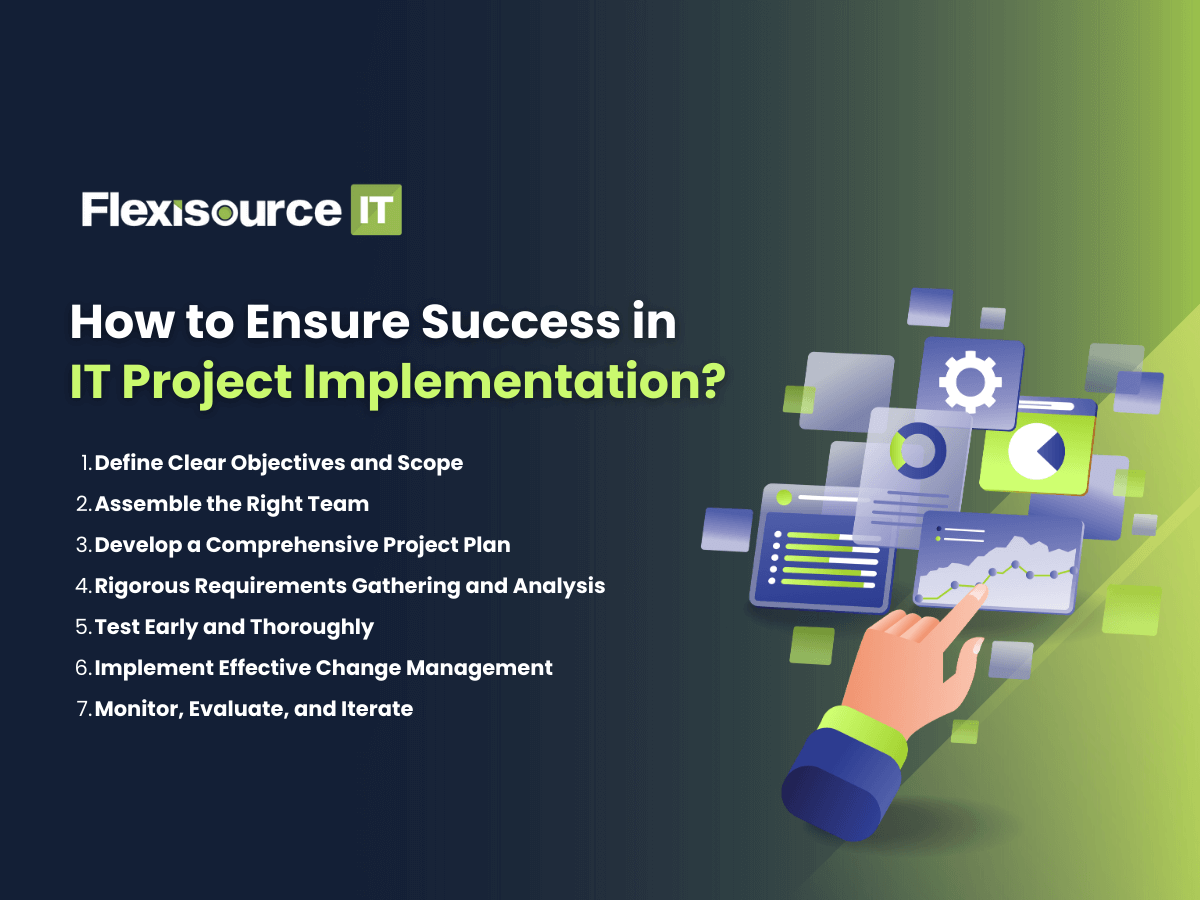In today’s fast-paced and technology-driven business landscape, successful IT project implementation is not just a strategic advantage but often a critical necessity for organisations aiming to remain competitive and innovative. Yet, the path to achieving a triumphant IT project outcome is laden with complexities and potential pitfalls that demand meticulous planning, expert execution, and a steadfast commitment to best practices.
Organisations must follow a structured approach to mitigate these risks and maximise the chances of success. Thus, this article will explore seven critical steps for a successful IT project implementation.
What is a Successful IT Project Implementation?
A successful IT project implementation is the culmination of a well-executed plan that results in the effective deployment and utilisation of information technology solutions within an organisation. It is characterised by achieving predefined goals, objectives, and desired outcomes while adhering to budget constraints and timelines.
Likewise, a successful IT project implementation involves several key elements:
- Aligns with Business Goals. The IT project must align with the organisation’s overarching business objectives and strategies. It should solve a specific problem, enhance efficiency, or contribute to achieving a competitive advantage.
- Meets Stakeholder Expectations. Successful implementations meet or exceed the expectations of key stakeholders, including end-users, management, and external partners. It ensures that the delivered solution addresses their needs and provides value.
- Delivered On-time. The project should adhere to the established timeline, preventing unnecessary delays that could impact the organisation’s operations or market competitiveness.
- Within Budget. Staying within the allocated budget is a hallmark of success. Cost overruns can strain resources and negatively affect the organisation’s financial health.
- Reliable and High Quality. The implemented IT solution should be of high quality and reliability. It should function as intended, be free of critical defects, and offer end-users a stable and secure environment.
- Scalable and Flexible. The solution should be designed to accommodate future growth and changes in business requirements. Scalability and flexibility enable the organisation to adapt to evolving needs without significant disruption.
- Mitigates Risks. Successful implementations involve identifying and mitigating risks proactively. This includes developing contingency plans and addressing potential challenges during the implementation process.
How to Ensure Success in IT Project Implementation?
As mentioned, ensuring success in IT project implementation involves careful planning, effective execution, and ongoing management. Here are key steps and strategies to help you achieve success:

1. Define Clear Objectives and Scope
A well-defined set of objectives and a clear project scope is the foundation of any successful IT project implementation. It ensures that the IT project is aligned with the organisation’s overall strategic goals and priorities. Likewise, it helps establish a direct link between the project’s outcomes and the business’s success.
So, before embarking on a project, it’s crucial to ask the following questions:
- What problem does this project aim to solve?
- What are the specific goals and outcomes we want to achieve?
- Who are the stakeholders, and what are their expectations?
- What is the budget and timeline for the project?
Answering these questions establishes a solid understanding of the project and creates a roadmap for success. In addition, a clear project scope helps prevent scope creep, where additional features or requirements are added mid-project, often leading to delays and budget overruns.
2. Assemble the Right Team
IT projects often involve complex technologies and systems. A team with the right technical skills and expertise is crucial for effectively designing, developing, implementing, and maintaining these systems. In addition, the right team ensures that the project meets high-quality standards.
Thus, to have a successful IT Project implementation, always assemble a team with the right skills, experience, and knowledge to execute the project effectively. Key team members may include:
- Project manager. They are responsible for overall project planning, coordination, and communication.
- Business analysts. They will gather and document requirements, ensuring alignment with business goals.
- Developers and engineers. They will build and configure the IT systems or software.
- Quality assurance professionals. They are the ones who are responsible for testing and validating the project deliverables for quality and reliability.
- Subject matter experts. They provide domain-specific knowledge and guidance.
3. Develop a Comprehensive Project Plan
A successful IT Project implementation always includes a comprehensive project plan. It is a detailed and structured document that outlines all aspects of the project, from its objectives and scope to its execution and completion. Likewise, this plan serves as a roadmap for the project team and stakeholders, providing a clear and organised framework for planning, executing, monitoring, and controlling the project.
To create a comprehensive IT project plan, identify the following:
- Project timeline. Clearly define project milestones and deadlines.
- Resource allocation. Specify the allocation of personnel, equipment, and budget.
- Risk assessment. Identify potential risks and creation of mitigation strategies.
- Task dependencies. Determine the order and interdependencies of project tasks.
- Change management. Develop a plan for handling changes and unexpected challenges.
Additionally, your project plan should be flexible enough to accommodate changes as they arise while ensuring they are thoroughly evaluated and their impact on the project is understood.
4. Rigorous Requirements Gathering and Analysis
Before diving into development, it’s essential to have a complete and accurate understanding of the project’s requirements. This phase involves working closely with stakeholders to gather and document their needs and expectations. Key activities in this step include:
- Conducting interviews and workshops with stakeholders.
- Creating use cases, user stories, or functional specifications.
- Prioritising requirements based on business value and urgency.
- Validating requirements with stakeholders to ensure alignment.
- Proper requirements gathering and analysis minimise the likelihood of misunderstandings, reduce the need for later revisions, and ensure that the project delivers the intended value.
5. Test Early and Thoroughly
Testing is a critical component of any successful IT project implementation. It helps identify and detect software and system errors, defects, and bugs. Likewise, it reduces the risk of post-implementation problems and ensures a smoother transition to production.
Thus, it’s essential to implement a comprehensive testing strategy covering the project’s different aspects, including functionality, performance, security, and usability. Key testing phases include:
- Unit testing. Testing individual components or modules.
- Integration testing. Ensuring that different parts work together as expected.
- User acceptance testing (UAT). Involving end-users to validate that the system meets their requirements.
- Performance testing. Assessing the system’s responsiveness and scalability.
- Security testing. Identifying and addressing vulnerabilities and potential threats.
6. Implement Effective Change Management
Change is inevitable in a thriving IT Project implementation. Still, any change can be resisted by employees accustomed to existing processes and technologies. Effective change management strategies can help mitigate these resistances and create a more positive attitude towards changes.
A good change management involves:
- Communicating changes to stakeholders. Keep everyone informed about what changes are occurring and why they are necessary.
- Training and support. Provide training to end-users and support staff to ensure a smooth transition.
- Handling resistance. Address resistance to change through education, communication, and involvement of key stakeholders.
- Monitoring and evaluation. Continuously assess the impact of changes and adjust as needed.
7. Monitor, Evaluate, and Iterate
Even after the project is live, the work isn’t over. Continuous monitoring and evaluation are essential to ensure the project’s ongoing success. This involves:
- Tracking key performance indicators (KPIs) to assess the project’s impact on the organisation.
- Gathering feedback from end-users and stakeholders to identify areas for improvement.
- Identifying and addressing any post-implementation issues promptly.
- Making necessary updates and enhancements based on feedback and changing business needs.
Incorporating feedback and data-driven insights into your project can lead to iterative improvements that align the IT solution with the organisation’s evolving goals.
Conclusion
Successful IT project implementation is a multifaceted process that demands careful planning, effective teamwork, and a commitment to continuous improvement. Following these seven critical steps mentioned in the article can significantly increase the likelihood of delivering an IT project that meets its goals.
To ensure the successful implementation of your IT project, consider partnering with Flexisource IT. Our expert team offers a wide range of IT services, including project management, development, and support, to help you achieve your project goals efficiently and effectively. Make sure to leave your IT project’s success to chance; hire Flexisource IT. Contact us today to learn more about our services and how we can support your IT project.





